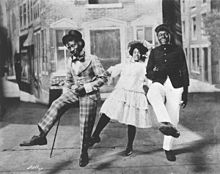| Cakewalk | |
|---|---|
 Five dancers perform a cakewalk, 1903 | |
| Stylistic origins | |
| Cultural origins | Southern United States |
| Derivative forms | Ragtime |



The cakewalk was a dance developed from the "prize walks" (dance contests with a cake awarded as the prize) held in the mid-19th century, generally at get-togethers on plantations where Black people had been enslaved, before and after emancipation in the Southern United States. Alternative names for the original form of the dance were "chalkline-walk", and the "walk-around". It was originally a processional partner dance performed with comical formality, and may have developed as a subtle mockery of the mannered dances of white slaveholders.
Following an exhibition of the cakewalk at the 1876 Centennial Exposition in Philadelphia, the cakewalk was adopted by performers in minstrel shows, where it was danced exclusively by men until the 1890s. At that point, Broadway shows featuring women began to include cakewalks, and grotesque dances became very popular across the country.[3]
The fluid and graceful steps of the dance may have given rise to the colloquialism that something accomplished with ease is a "cakewalk".[4]
- ^ Philip M. Peek, Kwesi Yankah, African Folklore: An Encyclopedia, 2003, p. 33. ISBN 0-203-49314-1.
- ^ "Basinstreet.com - Your Online Source for Historical Jazz". Archived from the original on 2015-04-19. Retrieved 2014-01-31.
- ^ Fletcher 1984, p. 103.
- ^ Gandhi, Lakshmi (December 23, 2013). "The Extraordinary Story Of Why A 'Cakewalk' Wasn't Always Easy". NPR. Retrieved 2019-07-23.